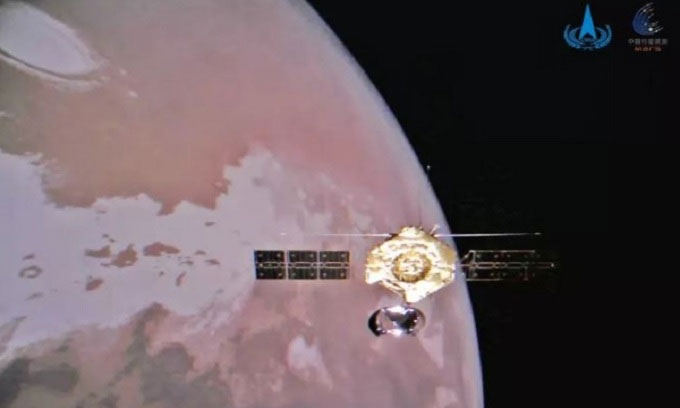The Tianwen-1 spacecraft has sent back a series of selfies for the New Year, captured by a small camera released to record images of the spacecraft in orbit around Mars.

Tianwen-1 flying over the northern pole of Mars. (Image: CNSA).
The new images released by the China National Space Administration (CNSA) show the Tianwen-1 spacecraft flying over the northern pole of Mars, with its solar panels and extended antennas deployed, along with close-up images of parts of the spacecraft orbiting the planet, and the icy cap at the northern region of the Red Planet. These Mars images were taken by a small camera released by Tianwen-1 and transmitted back to the spacecraft via WiFi.
The photos provide unprecedented views of a spacecraft in orbit around another planet, revealing the yellow body of Tianwen-1, its silver communication antennas, solar panels, and scientific instruments. In the close-up images, the spacecraft’s radar antenna is positioned parallel to the solar panels. Tianwen-1 has been orbiting Mars since February 2021 and successfully landed the Zhurong rover in May of the same year. The spacecraft also deployed a small camera to capture images of the probe in deep space.
This new series of images helps engineers assess the condition of Tianwen-1 after more than a year in deep space. “The spacecraft is orbiting Mars under very good conditions. We can see that the spacecraft is operational, with clear views of the solar panels and antenna devices,” said the chief designer of the Tianwen-1 system.
CNSA also provided updates on the Zhurong rover’s activities on the surface of the Red Planet, including images from three composite photos showing the landscape around the vehicle in the Utopia Planitia region. As of December 31, 2021, the rover has experienced 225 Martian days and has traveled a total of 1,400 meters.
Updates on the Zhurong rover have become less frequent due to interruptions when Earth and Mars are on opposite sides of the Sun, and as Tianwen-1 altered its orbit to begin its own scientific mission, reducing its role in communication for Zhurong, which is equipped with only a small antenna. In November 2021, the Mars Express spacecraft from the European Space Agency successfully collected data from the Zhurong rover and transmitted it back to Earth through a series of communication tests.


















































